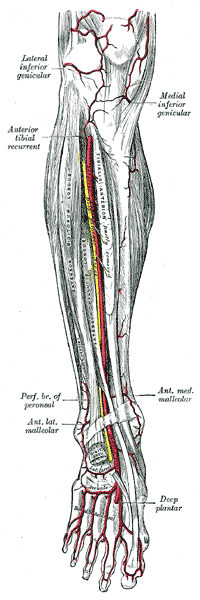Dorsalis pedis artery
(Redirected from Dorsalis pedis)
Dorsalis Pedis Artery[edit | edit source]
The dorsalis pedis artery is a blood vessel of the lower limb. It is a continuation of the anterior tibial artery and is located on the dorsum of the foot. This artery plays a crucial role in supplying blood to the foot and is often used clinically to assess the vascular status of the lower extremity.
Anatomy[edit | edit source]
The dorsalis pedis artery begins at the level of the ankle joint, as the anterior tibial artery crosses the ankle. It runs along the dorsal aspect of the foot, towards the first intermetatarsal space, where it divides into the first dorsal metatarsal artery and the deep plantar artery.
Course[edit | edit source]
The artery travels superficially, lying just beneath the skin and fascia, making it easily palpable in most individuals. It runs alongside the extensor hallucis longus tendon and is accompanied by the deep peroneal nerve.
Branches[edit | edit source]
The dorsalis pedis artery gives off several branches, including:
- The lateral tarsal artery
- The arcuate artery
- The first dorsal metatarsal artery
- The deep plantar artery
These branches contribute to the blood supply of the dorsal aspect of the foot and the toes.
Clinical Significance[edit | edit source]
The dorsalis pedis artery is commonly used in clinical practice to assess the peripheral circulation of the lower limb. The pulse of the dorsalis pedis artery can be palpated on the dorsum of the foot, lateral to the extensor hallucis longus tendon. Absence or diminution of this pulse can indicate peripheral vascular disease or other circulatory problems.
Related Pages[edit | edit source]
Search WikiMD
Ad.Tired of being Overweight? Try W8MD's NYC physician weight loss.
Semaglutide (Ozempic / Wegovy and Tirzepatide (Mounjaro / Zepbound) available. Call 718 946 5500.
Advertise on WikiMD
|
WikiMD's Wellness Encyclopedia |
| Let Food Be Thy Medicine Medicine Thy Food - Hippocrates |
Translate this page: - East Asian
中文,
日本,
한국어,
South Asian
हिन्दी,
தமிழ்,
తెలుగు,
Urdu,
ಕನ್ನಡ,
Southeast Asian
Indonesian,
Vietnamese,
Thai,
မြန်မာဘာသာ,
বাংলা
European
español,
Deutsch,
français,
Greek,
português do Brasil,
polski,
română,
русский,
Nederlands,
norsk,
svenska,
suomi,
Italian
Middle Eastern & African
عربى,
Turkish,
Persian,
Hebrew,
Afrikaans,
isiZulu,
Kiswahili,
Other
Bulgarian,
Hungarian,
Czech,
Swedish,
മലയാളം,
मराठी,
ਪੰਜਾਬੀ,
ગુજરાતી,
Portuguese,
Ukrainian
Medical Disclaimer: WikiMD is not a substitute for professional medical advice. The information on WikiMD is provided as an information resource only, may be incorrect, outdated or misleading, and is not to be used or relied on for any diagnostic or treatment purposes. Please consult your health care provider before making any healthcare decisions or for guidance about a specific medical condition. WikiMD expressly disclaims responsibility, and shall have no liability, for any damages, loss, injury, or liability whatsoever suffered as a result of your reliance on the information contained in this site. By visiting this site you agree to the foregoing terms and conditions, which may from time to time be changed or supplemented by WikiMD. If you do not agree to the foregoing terms and conditions, you should not enter or use this site. See full disclaimer.
Credits:Most images are courtesy of Wikimedia commons, and templates, categories Wikipedia, licensed under CC BY SA or similar.
Contributors: Prab R. Tumpati, MD

